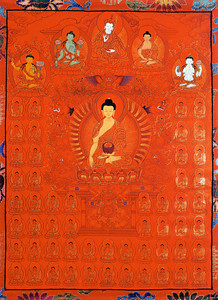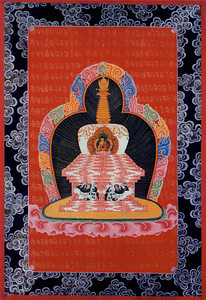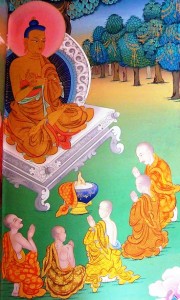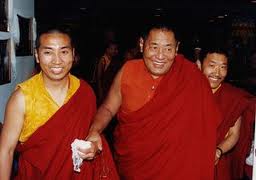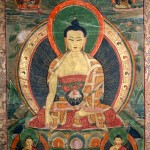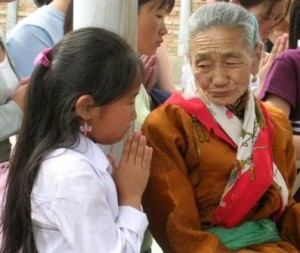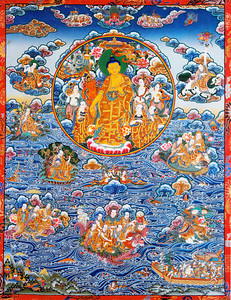
The following is an excerpt from a teaching by Jetsunma Ahkon Lhamo called “Faults of Cyclic Existence”
How is the understanding of compassion a clarifying thought as well as a motivating thought? How is it a clarifying thought? Now here is where the profound connection with refuge comes into play. Not only does the compassion motivate us to take refuge, but it makes us think it through very clearly. If we utilize it, it does.
When we enter onto the path of the Buddhadharma, we take refuge in the outer refuge of Buddha, Dharma, Sangha, the inner refuge of lama, yidam, khandro, and the secret refuge of the channels, winds and fluids. When we actually enter into this refuge, which for our purposes now are the Buddha, Dharma and Sangha, Triple Gem refuge, we must define why it must be arranged the way it is. Why is it organized the way it is? For instance, if it’s true that all sentient beings are suffering but they wish to be happy and they are mostly suffering due to desire and the confusion about issues concerning desire, if that’s what the Buddha said, then why don’t we just kind of sit down and have a therapeutic session of insight so that we can isolate for ourselves what it is that we actually want.And maybe then we can go and get it. If all sentient beings are really suffering and we’re really unhappy and we’re trying to be happy, why don’t we just have an insight of some kind and go for it!? Why don’t we do that? Well, because you’ve done that before. You’ve done that before. You do it all the time to greater or lesser degree, according to your capacity and your habitual tendency. In fact, we do that all of the time. We feel a need. We feel desire. We feel something. Something is moving that locomotive down the track. What is it? So we sit down and we try to center ourselves or we get busy and allow thoughts to come up. Each one of us has a characteristic way to deal with things. Maybe we’ll do a little journaling, we’ll do a little art, we’ll do a little music, we’ll do a little whatever, take a walk and try to center ourselves, and figure out what’s going on. Well, we’ll come up with something. You always come up with something
Now we’re going to figure out, “Oh , if I don’t get with the great love of my life pretty soon…, That’s what it is, I know that’s what it is.” So now you’re on to the next adventure. Or you may ask yourself,“What is it that’s troubling me? What is it that’s troubling me?” And you sit down and you’re reaching inside and using all this psychological technique and you’re going, “Oh it’s my mother!!! My mother didn’t love me!!” Each of these are valid. I’m not saying that these are not issues in your life. I’m not saying that these are not valid things to think about, but I am saying that there is some confusion there in that you are looking at the superficial causes for discomfort, but not the deeper ones.
If we were to look more deeply,, we would discover that the underlying cause of all suffering is desire, and that we’re real, real, real confused about this whole issue. So we examine the path and examine the teachings a little bit further. And we find that the Buddha has taught us that samsara is actually made up of the things that potentially make us suffer. That is to say that the first step or connection with samsara, that is the wheel of death and rebirth, is based on the idea, the first gossamer thin assumption or idea, of self-nature as being inherently real. Why does that happen? That happens because it can. End of subject. It’s one of the potentials in the great ground of primordial nature which contains within it all potentials. So this has happened. We have considered ourselves separate.
In order to consider one’s self as self nature separate, other has to be external. In order for other to be external, it has to be determined. In order for it to be determined, we have to react toward it. There has to be a reaction toward it with acceptance or rejection. You cannot see something without registering acceptance or rejection, or the combination of the two, which is neutrality. Neutrality is not lack of reaction. It is a combination of reactions. So we cannot experience anything as outside ourselves without some sort of reaction. And once that has happened, we react toward everything with hope and fear.
So everything in samsara is then built from that original structure of the idea of self nature being inherently real and at this point one’s self is determined, and other becomes external. We split into subjective-objective reality. Everything in samsara, every kind of perception with the senses, anything that we take in with our eyes, our ears, our tongues, anything that senses, comes from, at the root, that original construct, that original assumption of self-nature as being inherently real. So everything in samsara is built of that. That is to say that nothing that we experience now, nothing that we have ever experienced, is separate from the realm of desire. So literally, everything within samsara is potentially cause for more suffering.
Copyright © Jetsunma Ahkon Norbu Lhamo All rights reserved
